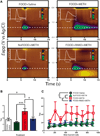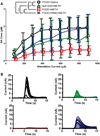Methamphetamine-induced dopamine terminal deficits in the nucleus accumbens are exacerbated by reward-associated cues and attenuated by CB1 receptor antagonism
- PMID: 22306525
- PMCID: PMC3518796
- DOI: 10.1016/j.neuropharm.2012.01.013
Methamphetamine-induced dopamine terminal deficits in the nucleus accumbens are exacerbated by reward-associated cues and attenuated by CB1 receptor antagonism
Abstract
Methamphetamine (METH) exposure is primarily associated with deleterious effects to dopaminergic neurons. While several studies have implicated the endocannabinoid system in METH's locomotor, rewarding and neurochemical effects, a role for this signaling system in METH's effects on dopamine terminal dynamics has not been elucidated. Given that CB1 receptor blockade reduces the acute potentiation of phasic extracellular dopamine release from other psychomotor stimulant drugs and that the degree of acute METH-induced increases in extracellular dopamine levels is related to the severity of dopamine depletion, we predicted that pretreatment with the CB1 receptor antagonist rimonabant would reduce METH-induced alterations at dopamine terminals. Furthermore, we hypothesized that administration of METH in environments where reward associated-cues were present would potentiate METH's acute effects on dopamine release in the nucleus accumbens and exacerbate changes in dopamine terminal activity. Fast-scan cyclic voltammetry was used to measure electrically-evoked dopamine release in the nucleus accumbens and revealed markers of compromised dopamine terminal integrity nine days after a single dose of METH. These were exacerbated in animals that received METH in the presence of reward-associated cues, and attenuated in rimonabant-pretreated animals. While these deficits in dopamine dynamics were associated with reduced operant responding on days following METH administration in animals treated with only METH, rimonabant-pretreated animals exhibited levels of operant responding comparable to control. Moreover, dopamine release correlated significantly with changes in lever pressing behavior that occurred on days following METH administration. Together these data suggest that the endocannabinoid system is involved in the subsecond dopaminergic response to METH.
Copyright © 2012 Elsevier Ltd. All rights reserved.
Figures





Similar articles
-
Endocannabinoids promote cocaine-induced impulsivity and its rapid dopaminergic correlates.Biol Psychiatry. 2014 Mar 15;75(6):487-98. doi: 10.1016/j.biopsych.2013.09.005. Epub 2013 Oct 17. Biol Psychiatry. 2014. PMID: 24138924 Free PMC article.
-
Methamphetamine-induced neurotoxicity disrupts naturally occurring phasic dopamine signaling.Eur J Neurosci. 2013 Jul;38(1):2078-88. doi: 10.1111/ejn.12209. Epub 2013 Apr 11. Eur J Neurosci. 2013. PMID: 23574406 Free PMC article.
-
Blockade by the cannabinoid CB1 receptor antagonist, rimonabant (SR141716), of the potentiation by quinelorane of food-primed reinstatement of food-seeking behavior.Neuropsychopharmacology. 2004 May;29(5):911-20. doi: 10.1038/sj.npp.1300370. Neuropsychopharmacology. 2004. PMID: 14694354
-
Is there a role for nitric oxide in methamphetamine-induced dopamine terminal degeneration?Neurotox Res. 2014 Feb;25(2):153-60. doi: 10.1007/s12640-013-9415-2. Epub 2013 Aug 6. Neurotox Res. 2014. PMID: 23918001 Free PMC article. Review.
-
Neuropsychotoxicity of abused drugs: involvement of matrix metalloproteinase-2 and -9 and tissue inhibitor of matrix metalloproteinase-2 in methamphetamine-induced behavioral sensitization and reward in rodents.J Pharmacol Sci. 2008 Jan;106(1):9-14. doi: 10.1254/jphs.fm0070139. Epub 2008 Jan 16. J Pharmacol Sci. 2008. PMID: 18198472 Review.
Cited by
-
HIV-1, methamphetamine and astrocytes at neuroinflammatory Crossroads.Front Microbiol. 2015 Oct 27;6:1143. doi: 10.3389/fmicb.2015.01143. eCollection 2015. Front Microbiol. 2015. PMID: 26579077 Free PMC article. Review.
-
Reduced levels of Cacna1c attenuate mesolimbic dopamine system function.Genes Brain Behav. 2017 Jun;16(5):495-505. doi: 10.1111/gbb.12371. Epub 2017 Mar 13. Genes Brain Behav. 2017. PMID: 28186690 Free PMC article.
-
Contrasting Regulation of Catecholamine Neurotransmission in the Behaving Brain: Pharmacological Insights from an Electrochemical Perspective.Pharmacol Rev. 2017 Jan;69(1):12-32. doi: 10.1124/pr.116.012948. Pharmacol Rev. 2017. PMID: 28267676 Free PMC article. Review.
-
Methamphetamine-induced neurotoxicity disrupts pharmacologically evoked dopamine transients in the dorsomedial and dorsolateral striatum.Neurotox Res. 2014 Aug;26(2):152-67. doi: 10.1007/s12640-014-9459-y. Epub 2014 Feb 22. Neurotox Res. 2014. PMID: 24562969 Free PMC article.
-
Effects of adolescent methamphetamine and nicotine exposure on behavioral performance and MAP-2 immunoreactivity in the nucleus accumbens of adolescent mice.Behav Brain Res. 2017 Apr 14;323:78-85. doi: 10.1016/j.bbr.2017.01.010. Epub 2017 Jan 12. Behav Brain Res. 2017. PMID: 28089854 Free PMC article.
References
-
- Ago Y, Araki R, Yano K, Hiramatsu N, Kawasaki T, Chaki S, Nakazato A, Onoe H, Hashimoto H, Baba A, Takuma K, Matsuda T. Activation of metabotropic glutamate 2/3 receptors attenuates methamphetamine-induced hyperlocomotion and increase in prefrontal serotonergic neurotransmission. Psychopharmacology (Berl) 2011;217:443–452. - PubMed
-
- Albers DS, Sonsalla PK. Methamphetamine-induced hyperthermia and dopaminergic neurotoxicity in mice: pharmacological profile of protective and nonprotective agents. J Pharmacol Exp Ther. 1995;275:1104–1114. - PubMed
-
- Anderson KL, Itzhak Y. Methamphetamine-induced selective dopaminergic neurotoxicity is accompanied by an increase in striatal nitrate in the mouse. Ann N Y Acad Sci. 2006;1074:225–233. - PubMed
Publication types
MeSH terms
Substances
Grants and funding
LinkOut - more resources
Full Text Sources
Medical

